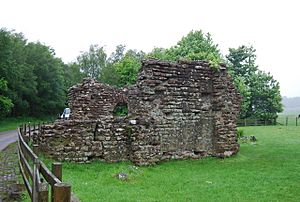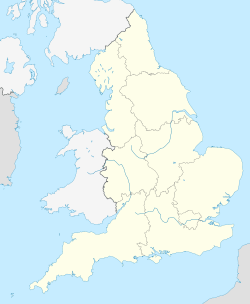Glannoventa facts for kids

Visible remains of the extra-mural
Ravenglass Roman Bath House. |
|
| Location | Ravenglass, Cumbria, England |
|---|---|
| Region | Brittania |
| Coordinates | 54°20′57″N 3°24′15″W / 54.34917°N 3.40417°W |
| Type | Fortification and settlement |
| History | |
| Founded | c.122 |
| Periods | Roman Imperial |
| Site notes | |
| Excavation dates | 1976-8 |
| Public access | yes |
Glannoventa was an important Roman fort and naval base located near Ravenglass in Cumbria, England. It was a key part of the Roman defenses in ancient Britain. The fort's name changed over time in old Roman records. For example, it was called Clanoventa in the 2nd century and Glannibanta later on.
A Roman army unit called the First Cohort Aelia Classica was based at Glannoventa around 158 AD. The name 'Aelia' came from the family name of Emperor Hadrian, who ruled from 117 to 138 AD. 'Classica' comes from the Latin word for 'fleet'. This suggests that these soldiers were originally part of the Roman navy.
Not much of the fort itself remains today. A railway line was built right through it in the 1800s. Also, one part of the fort has been worn away by the sea over time. A Roman road once connected Glannoventa to other sites further inland, like Hardknott.
What Was Outside the Fort?
The Roman Bath House
Just outside the fort, there was a large bath house. Its walls still stand about 4 meters (13 feet) high. You can even see some of its original brick archways. This building is sometimes called Walls Castle. It was built to the northeast of the main fort. Today, English Heritage looks after this ancient structure.
The Civilian Settlement (Vicus)
A vicus was a civilian settlement that grew up next to a Roman fort. It was where families of soldiers and traders lived. In 2013, a project began to dig up and explore the vicus at Glannoventa. This excavation has focused on areas that were first identified using special ground surveys.


